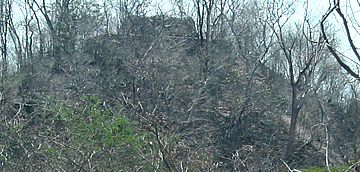

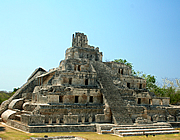
We stayed in quiet, colourful Campeche to visit Edzna, a once-powerful Mayan city with a host of fascinating structures including the impressive Palace of the Five Storeys.
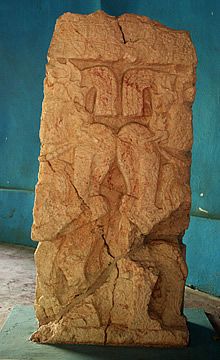
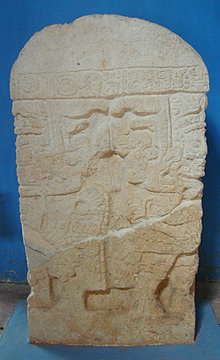
We set off at 8a.m. from Campeche with our guide Alfredo to visit Edzna while it was still reasonably cool.
The name may well derive from "House of the Itzas" creating the intriguing possibility that the Itza Maya were influential here long before arriving at Chichen Itza.1
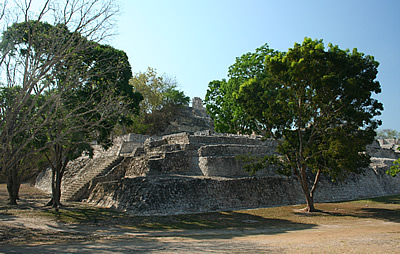
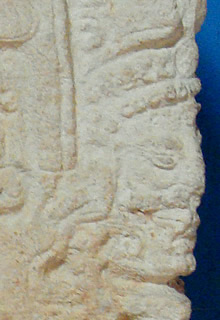
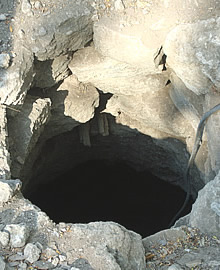
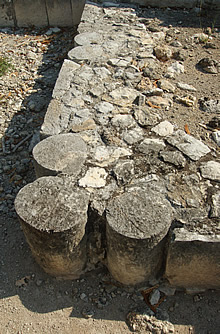
Some kind of settlement has existed at Edzna since as early as 400 B.C. but a recognizable city did not emerge until around 200 B.C. Edzna seems to have undergone two distinct phases of growth: the first between 400 and 150 B.C. and the second between 600 and 900 during its peak.2
Edzna lies in a particularly arid area and it is thanks to the most sophisticated of Mayan water collection and storage systems that the city was able to grow and flourish.
The main area of the excavated site is the magnificent Grand Acropolis, but there are several interesting structures surrounding this.
At the entrance there is a display of stelae found at the site. Two - 8 and 9 - are particularly interesting in that they are of paired individuals, back to back, whose features continue round corners.
Alfredo first took us to see a residential building with in situ stone beds and showed us one of the deep wells for water storage - one of many - called a chultun. These have narrow entrances, to mimimise evaporation, over a large hollowed out space. Often the surrounding area would have a gentle slope towards the entrance since the aim was to collect as much rainwater as possible.
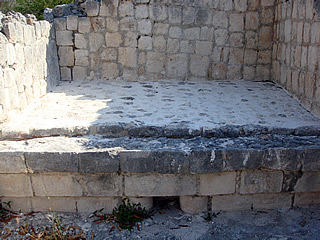
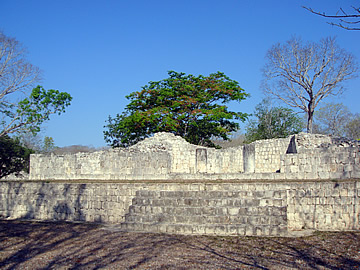
The long Platform of the Knives (so-called because of flint knives found on it) lies on the northern edge of the central zone of Edzna. It is a low platform with chambers on top and round columns at the entrance and was built during Edzna's golden period from 600-900. The use of round columns at Edzna is one of the features of the Yucatan Puuc style and found rarely elsewhere.3
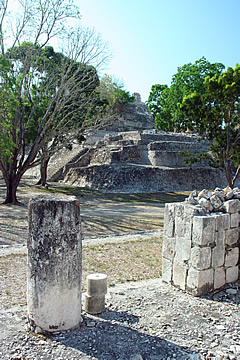
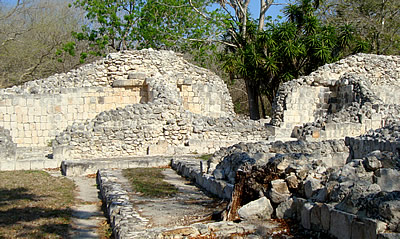
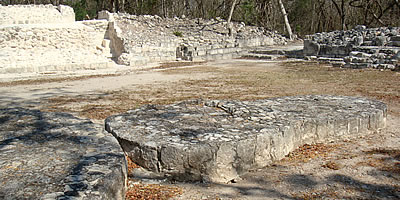
The Patio of the Ambassadors to the west of the Platform of the Knives, and named for sympathetic foreign ambassadors, is a number of structures built as late as the early post classic period 1000-1250. They are laid out rather haphazardly around a central space - clear apart from two curious low platforms next to each other. One of these is a keyhole shape the other circular with a hole in the centre.
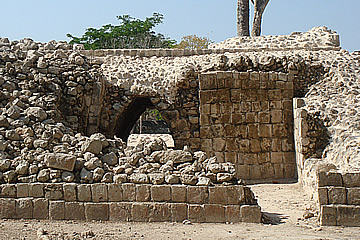
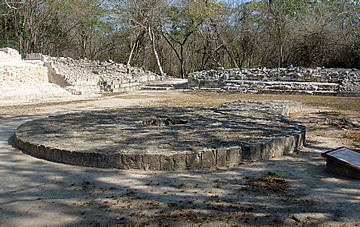
The structures have notable Puuc features: round columns and a typical, almost parabolic, arch. The round columns had square block capitals.

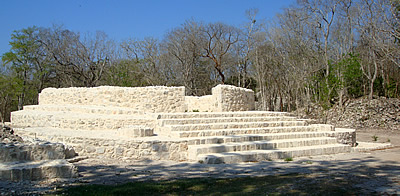
Near the viewing platform west of the Grand Acropolis is a small temple dedicated to the god of the wind. We were seeing it a little more than six months since it was restored, pristinely clean and dazzling in the bright sun.
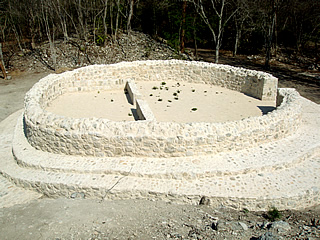
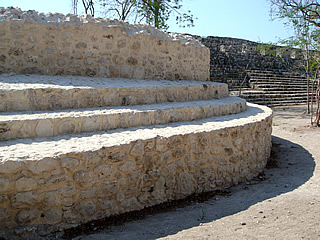
It is a very unusual oval shape and the building on top has a rectangular walled-off "inner sanctum".
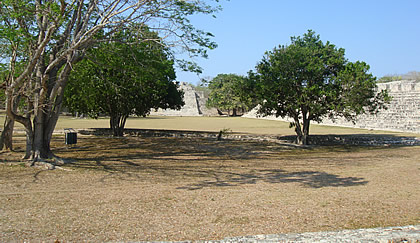

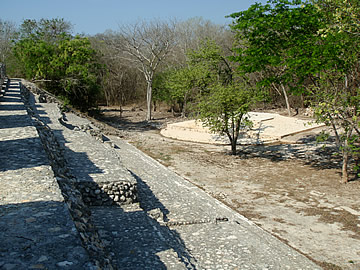
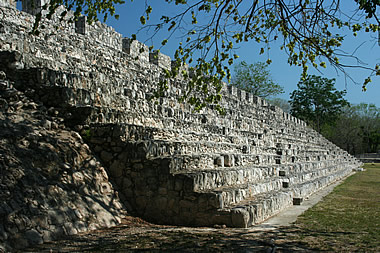
On the west side of the Great Acropolis stands the Nohoch Ná - the Large House. It seems to have been a viewing platform for events held in the Grand Plaza separating it from the Great Acropolis, or on the great Palace of the Five Storeys. Spectators could sit or stand on the terraces which ran along its 130m length and led up to enclosed galleries.
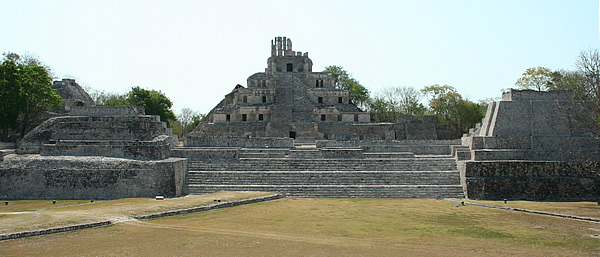
The view from the top of Nohoch Ná across to the Great Acropolis and the Palace of the Five Storeys is fantastic.
The Grand Plaza was traversed by two sacbéob, diagonally approaching the platform of the Great Acropolis. A sacbé - translated as "white road" - was often a long distance road connecting important centres. Within a city they may have been processional ways.3
The buildings around the Grand Plaza were painted different colours: on the north white associated with clouds, the palace/temple complex to the east was painted red associated with birth, life, sunrise. The Nohoch Ná was painted in dark colours signifying sunset and the underworld.
On the south side is the pyramidal South Temple which was painted yellow and, very unusually, does not face into the Grand Plaza but south.
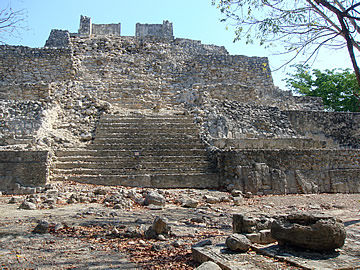
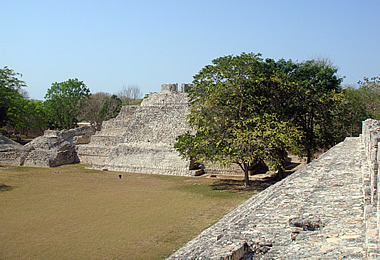
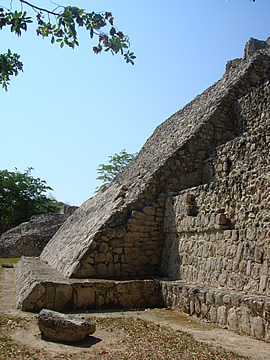
The temple is 11m high and has a steeply sloping ramp on the north face rather than a staircase. Ascent of the pyramid to the temple at the top was via the staircase on the south face. In front of the staircase there was a snake's head altar.
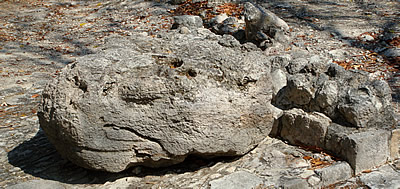
The snake is associated with rebirth by virtue of the process whereby it sheds its skin and emerges "reborn". Sacrifices made here would probably have been dedicated to rebirth after death.
Next to the South Temple is a very narrow ball court with the usual two parallel platforms separated by a space where the game was played. Each platform is sloped facing the court and topped by a gallery. There is thus quite a restricted space for people to watch the game, considering the size of the city. Perhaps this one was more of a ceremonial or religious contest watched only by priests and nobility.
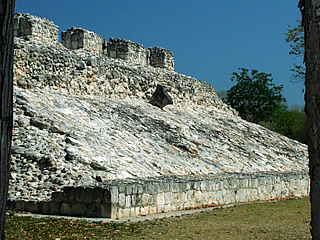
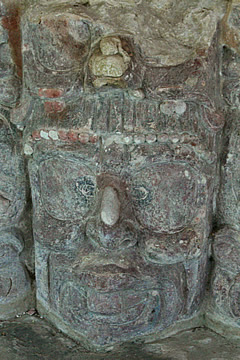
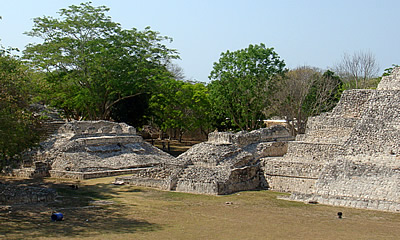
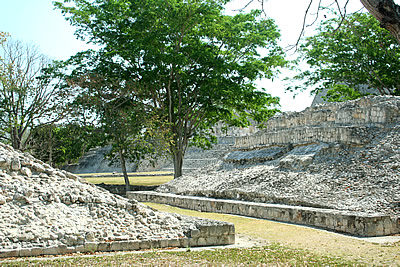
It is thought that the heavy rubber ball was supposed to be directed through rings - one high up on each side of the court - but this must have been difficult if not impossible as hands and feet could not be used! Both rings are missing from this court, one is lost, the other in Mexico City.
Ball players wore protection - a thick hip belt and knee guards - but captured warriors were made to play without protection (or so we were told) and since the ball was at least the size of a basketball and made of very hard rubber, they must have suffered injuries. After the game they were taken to the snake's head altar and sacrificed by having their throats cut.
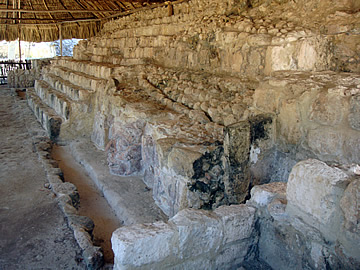
Nearby is a small temple heavily protected from the elements. Two masks in very good condition were discovered here when a wall collapsed during excavations.On the east the mask is of a young sun god representing sunrise, on the west an old sun god representing sunset. The conclusion is that this was a temple dedicated to sun worship.


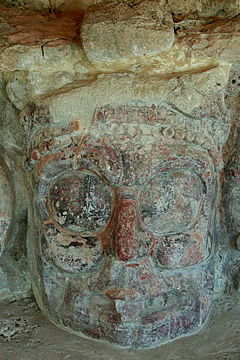
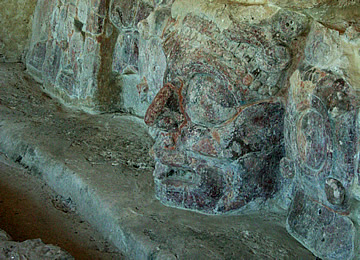
Substantial traces of paint, mostly red, ochre and bluish black, remain.

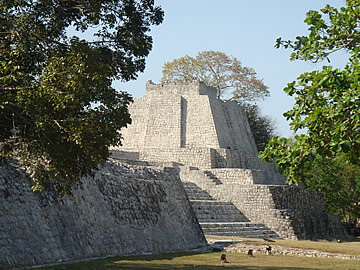
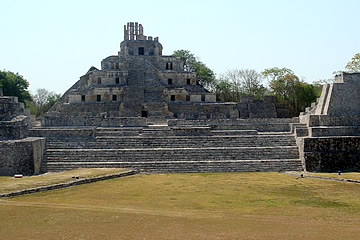
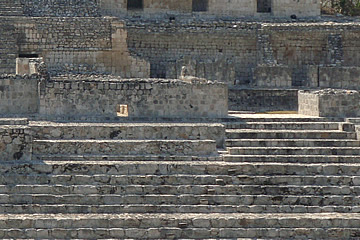
From the Temple of the Sun we made our way to the Great Acropolis and Edzna's most impressive structure: the Palace of the Five Storeys.
We climbed the steps of the structure which forms the western edge of the Great Acropolis flanked by two temples. These both once held tombs but had long since been robbed.
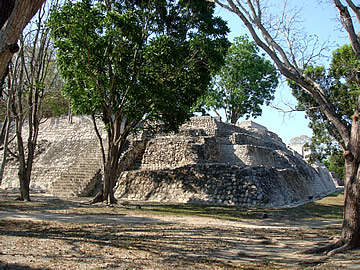
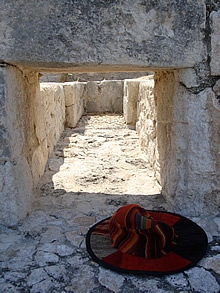
The great stairway between the two temples is beautifully terraced. At the top of the steps is the king's ritual sauna, a curious affair with a very low, small entrance, known as the Temazcal.2
The Grand Acropolis is a magnificent sight. Impressive buildings are set around the perimeter of a platform raised 8m above the surrounding land and 160m square. It was planned as a single entity rather than piecemeal, at the height of Edzna's prosperity.
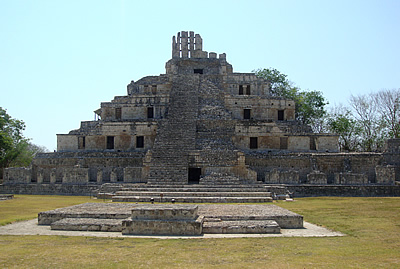
From the top of the great stairway the Palace of the Five Storeys stands directly opposite, an impressive structure.
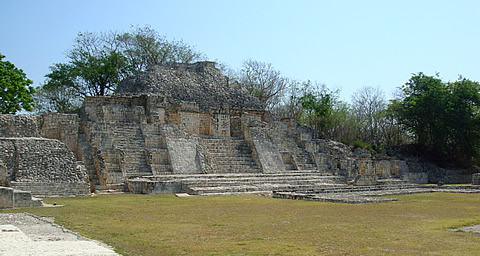
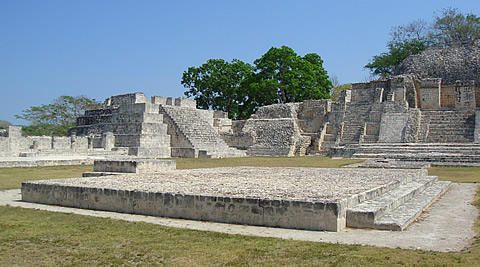
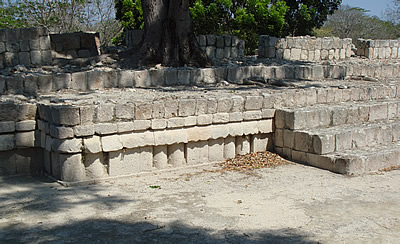
To the left (north) is a multi-chambered Puuc-style4 structure, its south face a complex of ramps, staircases and terraces3, sometimes called the North Temple.2
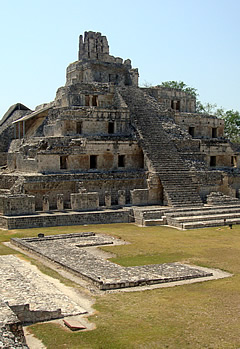
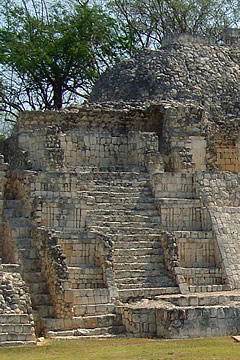
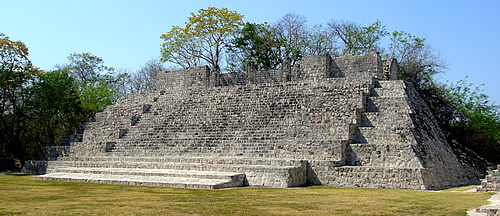
The "Puuc Patio", with many round pillars built into the base of the walls, is tucked into the corner of the Great Acropolis behind the "North Temple".
To the right (south) is the Petén-style4 Temple of the Moon, beautifully symmetric, perhaps over-restored, with a full width staircase and a temple on top.3
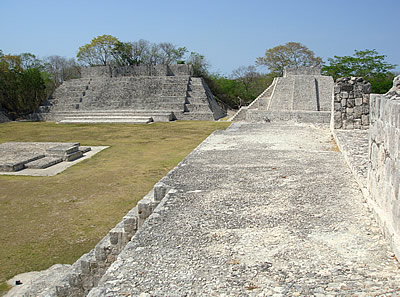
Edzna is often described as "straddling the building traditions of the Petén and Puuc".3
Petén architecture is found in the southern Yucatan and Northern Guatemala. Its characteristics include building complexes on raised platforms, stucco masks, roof combs and large plazas.
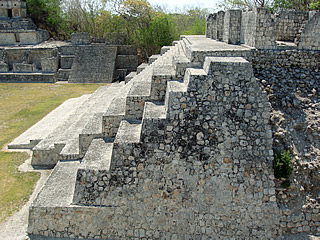
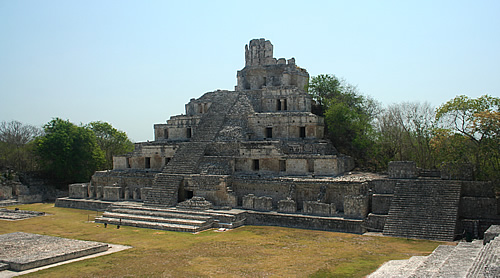
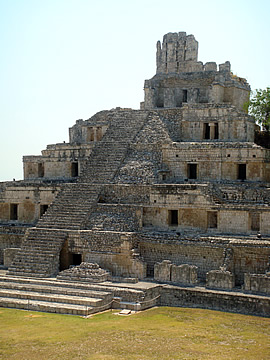
The Palace of the Five Storeys visible today dates from the Terminal Classic (900-1000A.D.) and was built over a much earlier phase which included a nine level pyramid topped with a temple.5
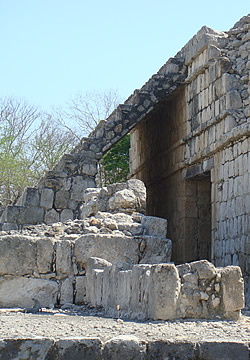
It has some unusual features. To start with, it is not just a mostly-solid pyramid but a honeycomb of rooms, leading to suggestions that this was also used for housing or admin as well as religious purposes, similar to the palace at Palenque.
Ceremonies would have been performed on the upper floors, public rituals probably on the level just below the roof comb which is easily visible from Nohoch Ná.
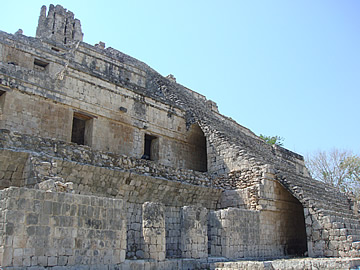
Secondly the staircase which leads up the front face of the building, only half restored, forms the sloping roof of passageways on the lower levels. On the second level of the palace there is a corbel arch in the passage thus formed .
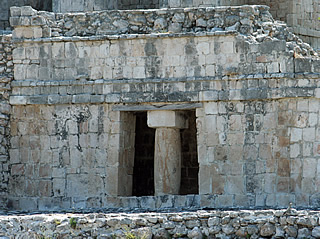
Another very unusual feature are the round columns with square capitals in some windows - a distinctly Puuc-style detail.
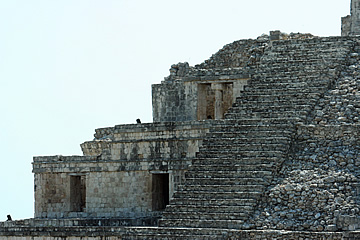
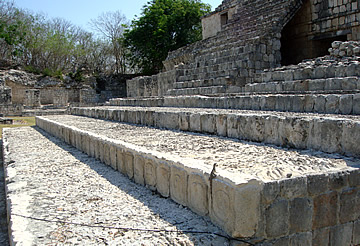
The short flight of steps leading to the first level is a hieroglyphic stairway, with glyphs on the front faces of the steps. There are more glyphs on the terraces to either side of the steps.
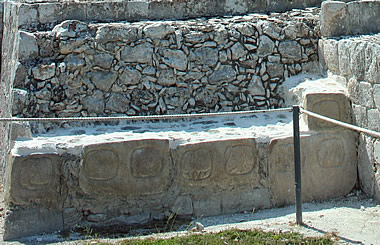
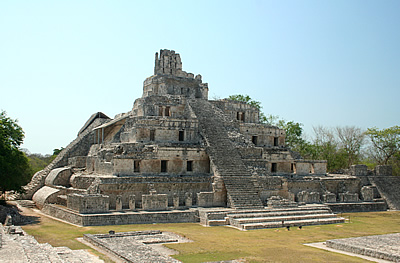
The palace had one more surprise for us: the north face has a series of elegant curved drops on either side of its stairway. This architecture is unique in the known Mayan world and our guide thought they were purely decorative, forming waterfalls when it rains. Higher up on the north face of the Early Classic (250-600 A.D.) structure are the remains of large masks, now protected from the elements.
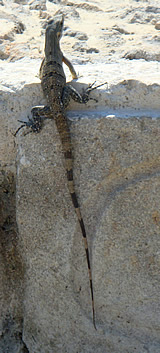
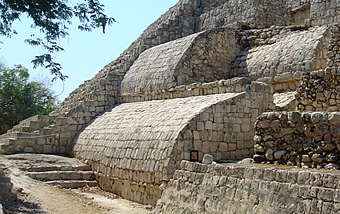
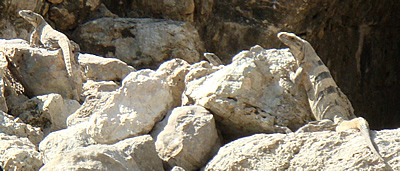
We were, as with several other sites, the only visitors. We gave a local guide a lift back to Campeche as there was no custom for him at Edzna. He was the guide who insisted on showing us Puerta de la Tierra in Campeche.
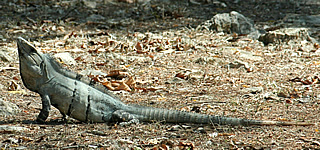
It was immensely atmospheric exploring Edzna and listening to the stories of its history, imagining the ceremonies, the masses of spectators on Nohoch Ná, the mysterious ball game and sacrifices.
We had been accompanied by a good number of basking iguanas, the odd lizard and a beautiful Motmot Bird.
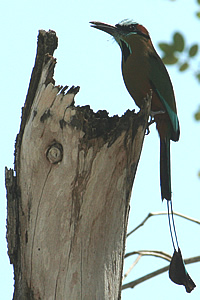
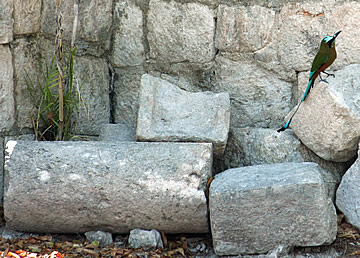
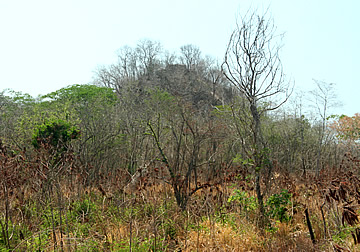
On the drive out we stopped to look at more ruins in the forest . On one pyramidal structure we could make out the remains of a small temple on the top and a ramp leading up one face. It's probable that we were looking at a temple called the "Old Witch", part of the Edzna site to the north west of the main complex. So much still to be investigated.
